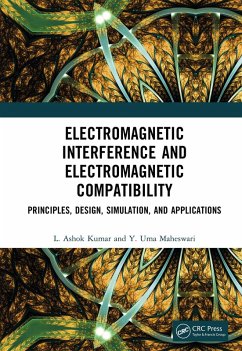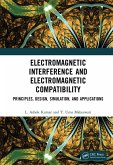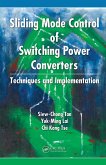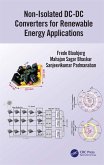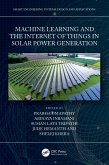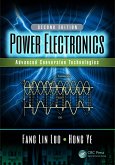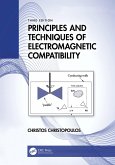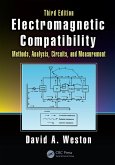Electromagnetic Interference and Electromagnetic Compatibility (eBook, PDF)
Principles, Design, Simulation, and Applications


Alle Infos zum eBook verschenken

Electromagnetic Interference and Electromagnetic Compatibility (eBook, PDF)
Principles, Design, Simulation, and Applications
- Format: PDF
- Merkliste
- Auf die Merkliste
- Bewerten Bewerten
- Teilen
- Produkt teilen
- Produkterinnerung
- Produkterinnerung

Hier können Sie sich einloggen

Bitte loggen Sie sich zunächst in Ihr Kundenkonto ein oder registrieren Sie sich bei bücher.de, um das eBook-Abo tolino select nutzen zu können.
Electromagnetic compatibility is concerned with the generation, transmission, and reception of electromagnetic energy. The book discusses about the basic principles of electromagnetic interference (EMI) and electromagnetic compatibility (EMC) including causes, events, and mitigation of issues. The design procedures for EMI filter, the types of filters, and filter implementation methods are explained. The simulation of printed circuit board designs using different software and a step-by-step method is discussed in detail. This book addresses the gap between theory and practice using case…mehr
- Geräte: PC
- mit Kopierschutz
- eBook Hilfe
![Electromagnetic Interference and Electromagnetic Compatibility (eBook, ePUB) Electromagnetic Interference and Electromagnetic Compatibility (eBook, ePUB)]() L. Ashok KumarElectromagnetic Interference and Electromagnetic Compatibility (eBook, ePUB)52,95 €
L. Ashok KumarElectromagnetic Interference and Electromagnetic Compatibility (eBook, ePUB)52,95 €![Sliding Mode Control of Switching Power Converters (eBook, PDF) Sliding Mode Control of Switching Power Converters (eBook, PDF)]() Siew-Chong TanSliding Mode Control of Switching Power Converters (eBook, PDF)75,95 €
Siew-Chong TanSliding Mode Control of Switching Power Converters (eBook, PDF)75,95 €![Non-Isolated DC-DC Converters for Renewable Energy Applications (eBook, PDF) Non-Isolated DC-DC Converters for Renewable Energy Applications (eBook, PDF)]() Frede BlaabjergNon-Isolated DC-DC Converters for Renewable Energy Applications (eBook, PDF)46,95 €
Frede BlaabjergNon-Isolated DC-DC Converters for Renewable Energy Applications (eBook, PDF)46,95 €![Machine Learning and the Internet of Things in Solar Power Generation (eBook, PDF) Machine Learning and the Internet of Things in Solar Power Generation (eBook, PDF)]() Machine Learning and the Internet of Things in Solar Power Generation (eBook, PDF)45,95 €
Machine Learning and the Internet of Things in Solar Power Generation (eBook, PDF)45,95 €![Power Electronics (eBook, PDF) Power Electronics (eBook, PDF)]() Fang Lin LuoPower Electronics (eBook, PDF)56,95 €
Fang Lin LuoPower Electronics (eBook, PDF)56,95 €![Principles and Techniques of Electromagnetic Compatibility (eBook, PDF) Principles and Techniques of Electromagnetic Compatibility (eBook, PDF)]() Christos ChristopoulosPrinciples and Techniques of Electromagnetic Compatibility (eBook, PDF)46,95 €
Christos ChristopoulosPrinciples and Techniques of Electromagnetic Compatibility (eBook, PDF)46,95 €![Electromagnetic Compatibility (eBook, PDF) Electromagnetic Compatibility (eBook, PDF)]() David A. WestonElectromagnetic Compatibility (eBook, PDF)214,95 €
David A. WestonElectromagnetic Compatibility (eBook, PDF)214,95 €-
-
-
Features:
- Discusses about the basic principles of EMI/EMC including causes and events
- Makes readers understand the problems in different applications because of EMI/EMC and the reducing methods
- Explores real-world case studies with code to provide hands-on experience
- Reviews design strategies for mitigation of noise
- Includes MATLAB, PSPICE, and ADS simulations for designing EMI Filter circuits.
The book is aimed at graduate students and researchers in electromagnetics, circuit and systems, and electrical engineering.
Dieser Download kann aus rechtlichen Gründen nur mit Rechnungsadresse in A, B, BG, CY, CZ, D, DK, EW, E, FIN, F, GR, HR, H, IRL, I, LT, L, LR, M, NL, PL, P, R, S, SLO, SK ausgeliefert werden.
- Produktdetails
- Verlag: Taylor & Francis eBooks
- Seitenzahl: 470
- Erscheinungstermin: 2. Oktober 2023
- Englisch
- ISBN-13: 9781000959345
- Artikelnr.: 68506862
- Verlag: Taylor & Francis eBooks
- Seitenzahl: 470
- Erscheinungstermin: 2. Oktober 2023
- Englisch
- ISBN-13: 9781000959345
- Artikelnr.: 68506862
- Herstellerkennzeichnung Die Herstellerinformationen sind derzeit nicht verfügbar.
Y. Uma Maheswari is a PhD scholar in Karpagam Academy of Higher Education. Currently working in Cognizant Technology Solutions, Coimbatore, she has around 22 years of experience in the field of PCB design, simulation software, and quality assurance engineering. She has completed her graduation programme in Electrical and Electronics Engineering, Amrita Institute of Technology, Coimbatore and her postgraduation programme in Embedded System Technologies, Anna University, Coimbatore. She has authored three books published by Elsevier, UK, Cambridge University Press, UK, and Nova Science publishers, US. She has also published many papers in national and international conferences and in reputed journals. She is also a Japanese Language Proficiency Test (JLPT) N3 Certificate holder.
Compatibility. 1.1 Electromagnetic Spectrum - Time Domain - Frequency
Domain. 1.2 Spectrum Analysis: Time Domain and Frequency Domain. 1.3 EMI
Effects on Humans and Other Electronic Appliances. 1.4 Basics of
Differential Mode current and common mode Current. 1.5 EMI ISSUES and
Mitigation. 1.6 Full-wave simulation techniques. 1.7 Equivalent series
resistance and equivalent series inductance. 1.8 Impedance and its Effect
on Electromagnetic Interference. 1.9 Materials. 1.10 EMC Testing. 1.11 EMC
Standards. References. Chapter 2. Electromagnetic Interference Events. 2.1
EMI Measurement Techniques. 2.2 Radiated Emissions. 2.3 Radiated Emissions
Checklist. 2.4 Radiated Emission Testing. 2.5 Test Setup for Radiated
Emission Measurement. 2.6 Conducted Emission. 2.7 Conducted Emissions
Checklist. 2.8 EMI Conducted Terminology. 2.9 Decible. 2.10 Standardized
Measurements of Conducted EMI. 2.11 Conducted Emission Testing. 2.12
Measurement Selectivity. 2.13 Measuring Detectors. 2.14 Parameters
Associated with EMI Measurement Techniques. 2.15 Troubleshooting at Your
Facility. 2.16 Susceptibility Models for Wires and PCB Lands. 2.17 Antenna
Design and Its Performance. 2.18 Conducted Susceptibility. 2.19
Troubleshooting at Your Facility. 2.20 Conducted Susceptibility Testing.
2.21 Circuit Topology. 2.22 Spread Spectrum Technique. 2.23 Spread Spectrum
Clock. 2.24 Soft Switching Techniques. 2.25 Hard Switched and Soft Switched
Power Converters. 2.26 Reduction in Printed Circuit Board (PCB).
References. Chapter 3. EMI Filter. 3.1 EMI Filter Source Impedance of
Various Power Lines. 3.2 Skin Effect. 3.3 Differences among Power Line
Measurements. 3.4 EMC Filter Design. 3.5 Adaptation Principle of EMI
Filters. 3.6 Electronic Filter Parameters. 3.7 Filter Configurations. 3.8
Operating Principle. 3.9 Insertion Loss. 3.10 Steps in the Design of a
Power Line EMI Filter. 3.11 Differential Mode (DM) vs Common Mode (CM)
Interference Currents. 3.12 Differential-Mode Design Goals. 3.13
Differential-Mode Filter Input Impedance. 3.14 Differential-Mode Filter
Output Impedance. 3.15 Input and Output Impedance for a DC Filter. 3.16
Common-Mode Design Goals. 3.17 Estimation of the Common-Mode Source
Impedance. 3.18 Methods of Reducing the Inductor Value due to High Current.
3.19 Design Criteria. 3.20 Component nonidealities. 3.21 High-frequency
differential-mode filtering. 3.22 Ferrite bead selection. 3.23 Filter
damping. 3.24 Filter Requirements. 3.25 Filter Selection. 3.26 Typical EMI
Filters. 3.27 Filter Components. 3.28 Filter Components- the Inductor.
References. Chapter 4. EMI/EMC Design for Printed Circuit Boards. 4.1
Controlling Emi Sources - Unintentional Sources. 4.2 Intentional Current
Spectrum. 4.3 Trace Current for Decoupling Analysis. 4.4 Internal
Differential Signal Lines. 4.5 I/O Differential Signal Lines. 4.6 Crosstalk
Analysis. 4.7 Printed Circuit Board Layout. 4.8 Pc Board Stack-Up. 4.9
Multi Layer Board. 4.10 Six Layer Board. 4.11 Four Layer Board. 4.12 One
and Two Layer Board. 4.13 Component Placement. 4.14 Isolation. 4.15 Power
Distribution for Two Layer Board. 4.16 Layout for Susceptibility.
References. Chapter 5. EMI and EMC Simulation Softwares. 5.1 EM Work. 5.2
EM Work Products. 5.3 A Transformer Software and Calculation. 5.4 A Motor
Software and a Calculator. 5.5 About HF WORKS. 5.6 Versatile High Frequency
and High-Speed Tool. 5.7 User Friendly Interface and Embedded Learning
Materials. 5.8 HFWORKS Add-Ins. 5.9 About Motor Wizard. 5.10 Features and
Capabilities. 5.11 Motor Wizard Results. 5.12 EM Works 2d. 5.13 Features
and Capabilities. 5.14 Applications. 5.15 Power Si. 5.16 Traditional Si
Simulation. 5.17 Power - Aware Solution. 5.18 Power - Aware Solution
Available in Sigrity Technology. 5.19 Features. 5.20 Benefits. 5.21 CST
Studio Suite. 5.22 Design Environment. 5.23 Simulation. 5.24 Applications.
5.25 Benefits. 5.26 Applications of Momentum 3d Planar Em Simulator. 5.27
COMSOL. 5.28 NEWFASANT. 5.29 Applications. 5.30 Mom Module For Antenna And
Rcs Design And Analysis. 5.31 BEM & FEM. 5.32 Finite Element Method
Magnetics. 5.33 Key Features. 5.34 EM Pro Software. 5.35 Empro Delivers The
Following Key Capabilities. 5.36 Finite Element Method (FEM). 5.37 Finite
Difference Time Domain (FDTD). 5.38 Typical Empro Applications. 5.39 Empro
Environment Overview. 5.40 MOTOR-CAD. 5.41 Ferritemagnetic Design Tool.
5.42 Emi Simulation Advances. 5.43 Buzz Around Emi Simulation. 5.44 Smaller
Electronics, Bigger Challenges. 5.45 Multi Physics Approach. 5.46 Evolving
Challenges. 5.47 Emi Software Meet-Up Standards. 5.48 Domain Standards.
References. Chapter 6. Instruments for EMI Measurements. 6.1 Need of
Instrumentation for EMI Measurements. 6.2 ESD Generator. 6.3 Reinforcement
Learning for Circuit Model Optimization. 6.4 RL-based Methodology for
Circuit-Optimization. 6.5 Line Impedance Stabilisation Network (LISN). 6.6
Network Analyser. 6.7 Spectrum Analyzer. 6.8 Signal Generators. 6.9 EMI
Measurement Using Antenna. 6.10 Surge Generators. 6.11 Current Probes. 6.12
Oscilloscopes. 6.13 EMI Receivers. 6.14 Near Field Probes. References.
Chapter 7. EMI using MATLAB. 7.1 About the Software. 7.2 Voltage Source
Three Level Inverter. 7.3 High Gain DC-DC Converter using Voltage
Multiplier. References. Chapter 8. EMI using PSPICE. 8.1. PSPICE
Introduction. 8.2 Bipolar Symmetric Output DC - DC Converter. 8.3
Multilevel Inverter for Grid Application. References. Chapter 9. EMI using
ADS. 9.1 About he Software and Introduction. 9.2 Interleaved Buck-Boost
Converter for Single Phase onboard Charger for Electric Vehicle. 9.3
Motoring Mode for Low Power EV using Buck Converter. 9.4.Buck-Boost DC-DC
Converter with Coupled-Inductor for Solar PV Applications. References
Compatibility. 1.1 Electromagnetic Spectrum - Time Domain - Frequency
Domain. 1.2 Spectrum Analysis: Time Domain and Frequency Domain. 1.3 EMI
Effects on Humans and Other Electronic Appliances. 1.4 Basics of
Differential Mode current and common mode Current. 1.5 EMI ISSUES and
Mitigation. 1.6 Full-wave simulation techniques. 1.7 Equivalent series
resistance and equivalent series inductance. 1.8 Impedance and its Effect
on Electromagnetic Interference. 1.9 Materials. 1.10 EMC Testing. 1.11 EMC
Standards. References. Chapter 2. Electromagnetic Interference Events. 2.1
EMI Measurement Techniques. 2.2 Radiated Emissions. 2.3 Radiated Emissions
Checklist. 2.4 Radiated Emission Testing. 2.5 Test Setup for Radiated
Emission Measurement. 2.6 Conducted Emission. 2.7 Conducted Emissions
Checklist. 2.8 EMI Conducted Terminology. 2.9 Decible. 2.10 Standardized
Measurements of Conducted EMI. 2.11 Conducted Emission Testing. 2.12
Measurement Selectivity. 2.13 Measuring Detectors. 2.14 Parameters
Associated with EMI Measurement Techniques. 2.15 Troubleshooting at Your
Facility. 2.16 Susceptibility Models for Wires and PCB Lands. 2.17 Antenna
Design and Its Performance. 2.18 Conducted Susceptibility. 2.19
Troubleshooting at Your Facility. 2.20 Conducted Susceptibility Testing.
2.21 Circuit Topology. 2.22 Spread Spectrum Technique. 2.23 Spread Spectrum
Clock. 2.24 Soft Switching Techniques. 2.25 Hard Switched and Soft Switched
Power Converters. 2.26 Reduction in Printed Circuit Board (PCB).
References. Chapter 3. EMI Filter. 3.1 EMI Filter Source Impedance of
Various Power Lines. 3.2 Skin Effect. 3.3 Differences among Power Line
Measurements. 3.4 EMC Filter Design. 3.5 Adaptation Principle of EMI
Filters. 3.6 Electronic Filter Parameters. 3.7 Filter Configurations. 3.8
Operating Principle. 3.9 Insertion Loss. 3.10 Steps in the Design of a
Power Line EMI Filter. 3.11 Differential Mode (DM) vs Common Mode (CM)
Interference Currents. 3.12 Differential-Mode Design Goals. 3.13
Differential-Mode Filter Input Impedance. 3.14 Differential-Mode Filter
Output Impedance. 3.15 Input and Output Impedance for a DC Filter. 3.16
Common-Mode Design Goals. 3.17 Estimation of the Common-Mode Source
Impedance. 3.18 Methods of Reducing the Inductor Value due to High Current.
3.19 Design Criteria. 3.20 Component nonidealities. 3.21 High-frequency
differential-mode filtering. 3.22 Ferrite bead selection. 3.23 Filter
damping. 3.24 Filter Requirements. 3.25 Filter Selection. 3.26 Typical EMI
Filters. 3.27 Filter Components. 3.28 Filter Components- the Inductor.
References. Chapter 4. EMI/EMC Design for Printed Circuit Boards. 4.1
Controlling Emi Sources - Unintentional Sources. 4.2 Intentional Current
Spectrum. 4.3 Trace Current for Decoupling Analysis. 4.4 Internal
Differential Signal Lines. 4.5 I/O Differential Signal Lines. 4.6 Crosstalk
Analysis. 4.7 Printed Circuit Board Layout. 4.8 Pc Board Stack-Up. 4.9
Multi Layer Board. 4.10 Six Layer Board. 4.11 Four Layer Board. 4.12 One
and Two Layer Board. 4.13 Component Placement. 4.14 Isolation. 4.15 Power
Distribution for Two Layer Board. 4.16 Layout for Susceptibility.
References. Chapter 5. EMI and EMC Simulation Softwares. 5.1 EM Work. 5.2
EM Work Products. 5.3 A Transformer Software and Calculation. 5.4 A Motor
Software and a Calculator. 5.5 About HF WORKS. 5.6 Versatile High Frequency
and High-Speed Tool. 5.7 User Friendly Interface and Embedded Learning
Materials. 5.8 HFWORKS Add-Ins. 5.9 About Motor Wizard. 5.10 Features and
Capabilities. 5.11 Motor Wizard Results. 5.12 EM Works 2d. 5.13 Features
and Capabilities. 5.14 Applications. 5.15 Power Si. 5.16 Traditional Si
Simulation. 5.17 Power - Aware Solution. 5.18 Power - Aware Solution
Available in Sigrity Technology. 5.19 Features. 5.20 Benefits. 5.21 CST
Studio Suite. 5.22 Design Environment. 5.23 Simulation. 5.24 Applications.
5.25 Benefits. 5.26 Applications of Momentum 3d Planar Em Simulator. 5.27
COMSOL. 5.28 NEWFASANT. 5.29 Applications. 5.30 Mom Module For Antenna And
Rcs Design And Analysis. 5.31 BEM & FEM. 5.32 Finite Element Method
Magnetics. 5.33 Key Features. 5.34 EM Pro Software. 5.35 Empro Delivers The
Following Key Capabilities. 5.36 Finite Element Method (FEM). 5.37 Finite
Difference Time Domain (FDTD). 5.38 Typical Empro Applications. 5.39 Empro
Environment Overview. 5.40 MOTOR-CAD. 5.41 Ferritemagnetic Design Tool.
5.42 Emi Simulation Advances. 5.43 Buzz Around Emi Simulation. 5.44 Smaller
Electronics, Bigger Challenges. 5.45 Multi Physics Approach. 5.46 Evolving
Challenges. 5.47 Emi Software Meet-Up Standards. 5.48 Domain Standards.
References. Chapter 6. Instruments for EMI Measurements. 6.1 Need of
Instrumentation for EMI Measurements. 6.2 ESD Generator. 6.3 Reinforcement
Learning for Circuit Model Optimization. 6.4 RL-based Methodology for
Circuit-Optimization. 6.5 Line Impedance Stabilisation Network (LISN). 6.6
Network Analyser. 6.7 Spectrum Analyzer. 6.8 Signal Generators. 6.9 EMI
Measurement Using Antenna. 6.10 Surge Generators. 6.11 Current Probes. 6.12
Oscilloscopes. 6.13 EMI Receivers. 6.14 Near Field Probes. References.
Chapter 7. EMI using MATLAB. 7.1 About the Software. 7.2 Voltage Source
Three Level Inverter. 7.3 High Gain DC-DC Converter using Voltage
Multiplier. References. Chapter 8. EMI using PSPICE. 8.1. PSPICE
Introduction. 8.2 Bipolar Symmetric Output DC - DC Converter. 8.3
Multilevel Inverter for Grid Application. References. Chapter 9. EMI using
ADS. 9.1 About he Software and Introduction. 9.2 Interleaved Buck-Boost
Converter for Single Phase onboard Charger for Electric Vehicle. 9.3
Motoring Mode for Low Power EV using Buck Converter. 9.4.Buck-Boost DC-DC
Converter with Coupled-Inductor for Solar PV Applications. References
